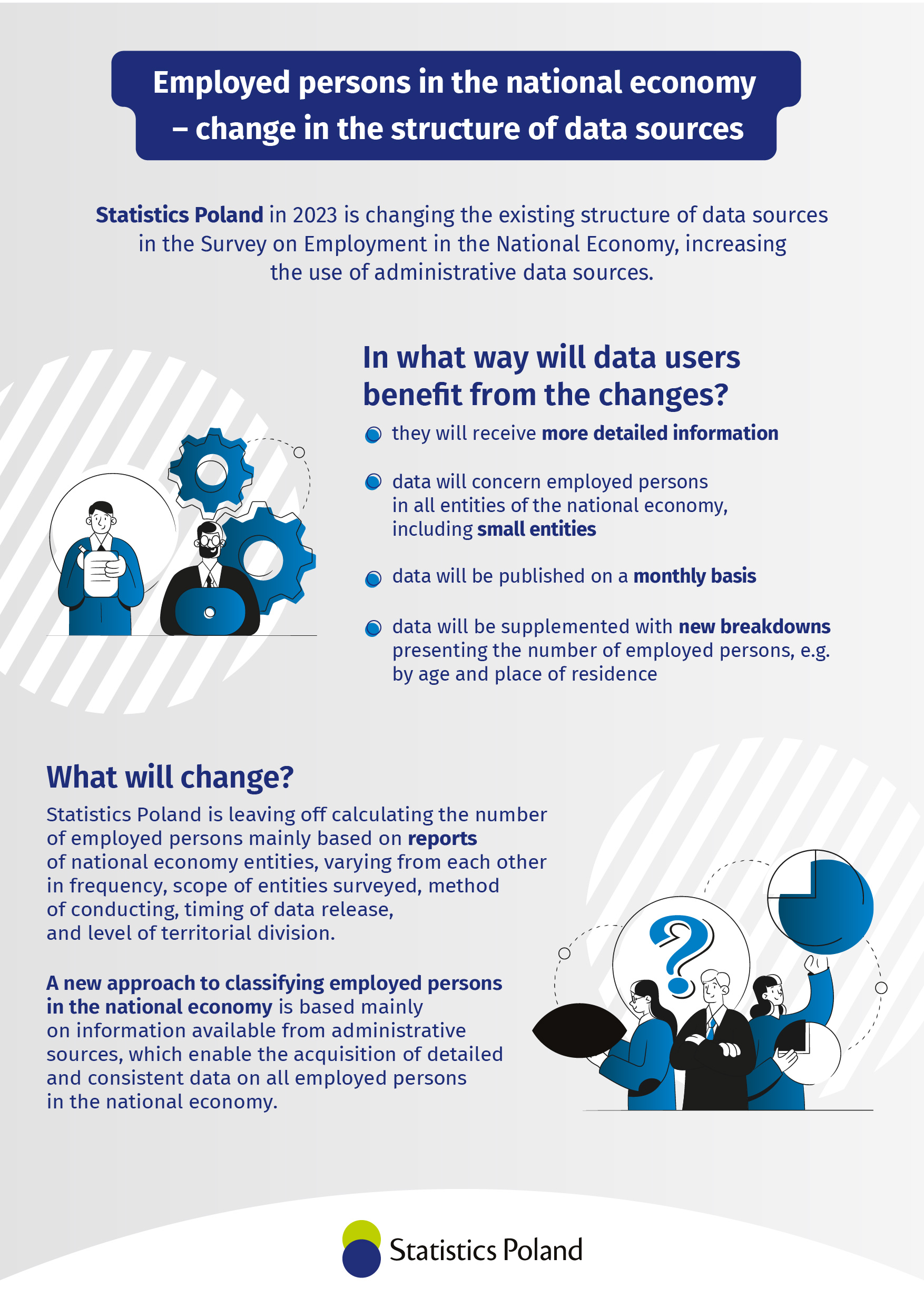Information from Statistics Poland on the change in the structure of data sources in the Survey on Employment in the National Economy, introduced in 2023
25 May this year, we will publish news release „Employment in the national economy in December 2022”. The publication takes into account the changes resulting from the increased share of administrative sources in the survey. Check how data users will benefit from the changes.
Until the end of 2022, the primary source of data in the Survey on Employment in the National Economy was the reports of national economy entities. The development of a methodology for obtaining information on employed persons from official registers made it possible to increase the use of administrative data in the survey. From 2023 onwards, the registers and information systems of the Agricultural Social Insurance Fund (KRUS), the Social Insurance Institution (ZUS) and the Ministry of Finance (MF) are the main source of data for statistics on the employed. Data from KRUS and ZUS contain information on persons subject to social insurance and health insurance and their contribution payers, and data from MF contain information on taxpayers.

Employed persons
Increasing the share of administrative sources in the Survey on Employment in the National Economy allows to provide users with additional, hitherto unavailable information on the employed, without introducing significant changes in the survey methodology. Minor methodological differences result from the different approach to classifying, for instance, farmers or persons employed for vocational training (see Table 1) as employed. In order to determine the number of employed persons based on administrative sources, information on the status of being insured at KRUS and the insurance title at ZUS is crucial. Based on this information, for each person insured at KRUS or ZUS, it is determined whether he or she is an employed person.
When determining the number of employed persons, each employed person is counted only once. For this purpose, the main job is determined for them. All data on employed persons in the national economy are presented in relation to their main job.
An employment status is also determined for each employed person, i.e:
- employee,
- self-employed person,
- member of a production cooperative,
- contributing family worker,
- outworker,
- clergyman.
Data on the number of employed persons in the national economy in the main job are given in persons as at the end of the month.
Information on retirees and pensioners refers to employed persons who have informed their contribution payers that they have an established right to a retirement pension or other pension. The data do not include information on retirees and pensioners insured at KRUS.
Information on disabled persons refers to employed persons who have a disability certificate and have submitted it to their contribution payer. The data do not include information on disabled persons insured at KRUS.
The data on foreigners do not include information on foreigners insured at KRUS.
Table. 1. Differences in classifying people as employed persons depending on the data source
|
Specification |
Employed persons in the national economy |
|
|
entities’ reports |
Administrative data sources |
|
|
Owners, co-owners and tenants of private farms (including contributing family workers) |
the condition for being counted as an employed person is exceeding a certain size of the farm's area measured in hectares of utilised agricultural area or the threshold values for special branches of agricultural production |
the condition for being counted as an employed person is the fact of being fully insured at KRUS, i.e. simultaneously insured with accident, sickness and maternity insurance and pension insurance |
|
Persons employed under an employment contract for vocational training |
are not counted as employed persons |
it is not possible to distinguish in the survey persons employed under an employment contract for vocational training employed persons include juvenile workers, who are a group that largely overlaps with the group of persons employed under an employment contract for vocational training |
|
Persons receiving rehabilitation benefits |
are not counted as employed persons |
are counted as employed persons |
|
Persons on childcare leave |
are not counted as employed persons if they are on childcare leave for more than 3 months (continuously) |
are counted as employed persons regardless of the length of their childcare leave |
|
Persons on unpaid leave |
are not counted as employed persons if they are on unpaid leave for more than 3 months (continuously) |
are not counted as employed persons if they are on unpaid leave for at least 1 month (continuously) |
Source: own elaboration
More information:

